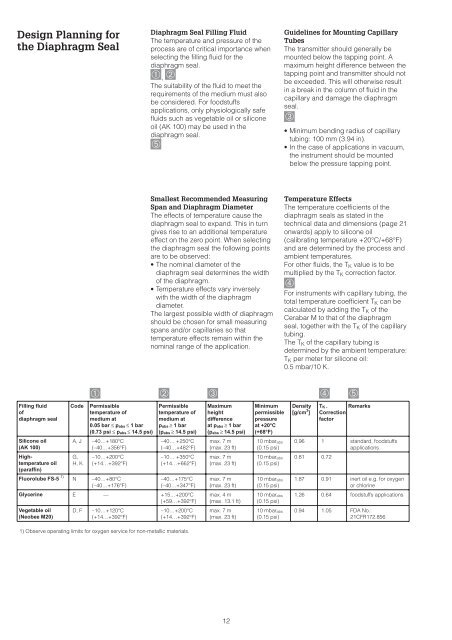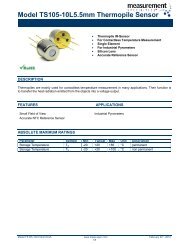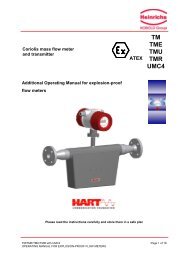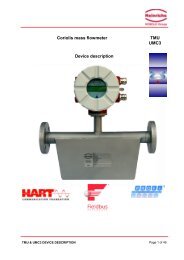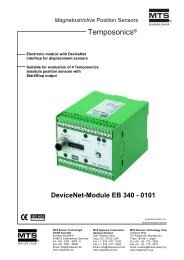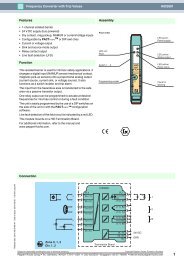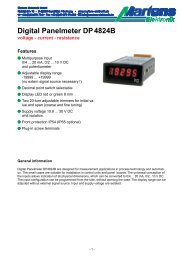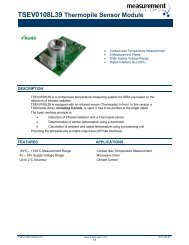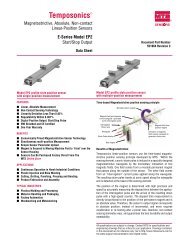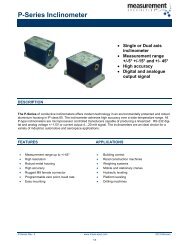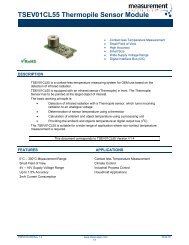Pressure Transmitter cerabar M PMP 46 cerabar M PMP 48
Pressure Transmitter cerabar M PMP 46 cerabar M PMP 48
Pressure Transmitter cerabar M PMP 46 cerabar M PMP 48
You also want an ePaper? Increase the reach of your titles
YUMPU automatically turns print PDFs into web optimized ePapers that Google loves.
Design Planning for<br />
the Diaphragm Seal<br />
Filling fluid<br />
of<br />
diaphragm seal<br />
Silicone oil<br />
(AK 100)<br />
Hightemperature<br />
oil<br />
(paraffin)<br />
Fluorolube FS-5 1)<br />
Code Permissible<br />
temperature of<br />
medium at<br />
0.05 bar ≤ pabs ≤ 1 bar<br />
(0.73 psi ≤ pabs ≤ 14.5 psi)<br />
A, J –40…+180°C<br />
(–40…+356°F)<br />
G,<br />
H, K<br />
–10…+200°C<br />
(+14…+392°F)<br />
N –40…+80°C<br />
(–40…+176°F)<br />
Diaphragm Seal Filling Fluid<br />
The temperature and pressure of the<br />
process are of critical importance when<br />
selecting the filling fluid for the<br />
diaphragm seal.<br />
➀, ➁<br />
The suitability of the fluid to meet the<br />
requirements of the medium must also<br />
be considered. For foodstuffs<br />
applications, only physiologically safe<br />
fluids such as vegetable oil or silicone<br />
oil (AK 100) may be used in the<br />
diaphragm seal.<br />
➄<br />
Smallest Recommended Measuring<br />
Span and Diaphragm Diameter<br />
The effects of temperature cause the<br />
diaphragm seal to expand. This in turn<br />
gives rise to an additional temperature<br />
effect on the zero point. When selecting<br />
the diaphragm seal the following points<br />
are to be observed:<br />
• The nominal diameter of the<br />
diaphragm seal determines the width<br />
of the diaphragm.<br />
• Temperature effects vary inversely<br />
with the width of the diaphragm<br />
diameter.<br />
The largest possible width of diaphragm<br />
should be chosen for small measuring<br />
spans and/or capillaries so that<br />
temperature effects remain within the<br />
nominal range of the application.<br />
Permissible<br />
temperature of<br />
medium at<br />
pabs ≥ 1 bar<br />
(pabs ≥ 14.5 psi)<br />
–40… +250°C<br />
(–40…+<strong>48</strong>2°F)<br />
–10… +350°C<br />
(+14…+662°F)<br />
–40…+175°C<br />
(–40…+347°F)<br />
Glycerine E — +15…+200°C<br />
(+59…+392°F)<br />
Vegetable oil<br />
(Neobee M20)<br />
Maximum<br />
height<br />
difference<br />
at pabs ≥ 1 bar<br />
(pabs ≥ 14.5 psi)<br />
max. 7 m<br />
(max. 23 ft)<br />
max. 7 m<br />
(max. 23 ft)<br />
Minimum<br />
permissible<br />
pressure<br />
at +20°C<br />
(+68°F)<br />
10 mbarabs<br />
(0.15 psi)<br />
10 mbarabs<br />
(0.15 psi)<br />
Guidelines for Mounting Capillary<br />
Tubes<br />
The transmitter should generally be<br />
mounted below the tapping point. A<br />
maximum height difference between the<br />
tapping point and transmitter should not<br />
be exceeded. This will otherwise result<br />
in a break in the column of fluid in the<br />
capillary and damage the diaphragm<br />
seal.<br />
➂<br />
• Minimum bending radius of capillary<br />
tubing: 100 mm (3.94 in).<br />
• In the case of applications in vacuum,<br />
the instrument should be mounted<br />
below the pressure tapping point.<br />
Temperature Effects<br />
The temperature coefficients of the<br />
diaphragm seals as stated in the<br />
technical data and dimensions (page 21<br />
onwards) apply to silicone oil<br />
(calibrating temperature +20°C/+68°F)<br />
and are determined by the process and<br />
ambient temperatures.<br />
For other fluids, the TK value is to be<br />
multiplied by the TK correction factor.<br />
➃<br />
For instruments with capillary tubing, the<br />
total temperature coefficient TK can be<br />
calculated by adding the TK of the<br />
Cerabar M to that of the diaphragm<br />
seal, together with the TK of the capillary<br />
tubing.<br />
The TK of the capillary tubing is<br />
determined by the ambient temperature:<br />
TK per meter for silicone oil:<br />
0.5 mbar/10 K.<br />
➀ ➁ ➂ ➃ ➄<br />
D, F –10…+120°C<br />
(+14…+392°F)<br />
–10…+200°C<br />
(+14…+392°F)<br />
1) Observe operating limits for oxygen service for non-metallic materials.<br />
max. 7 m<br />
(max. 23 ft)<br />
max. 4 m<br />
(max. 13.1 ft)<br />
max. 7 m<br />
(max. 23 ft)<br />
12<br />
10 mbarabs<br />
(0.15 psi)<br />
10 mbarabs<br />
(0.15 psi)<br />
10 mbarabs<br />
(0.15 psi)<br />
Density<br />
[g/cm 3 ]<br />
TK - Remarks<br />
Correction<br />
factor<br />
0,96 1 standard, foodstuffs<br />
applications<br />
0.81 0.72<br />
1.87 0.91 inert oil e.g. for oxygen<br />
or chlorine<br />
1.26 0.64 foodstuffs applications<br />
0.94 1.05 FDA No.:<br />
21CFR172.856


